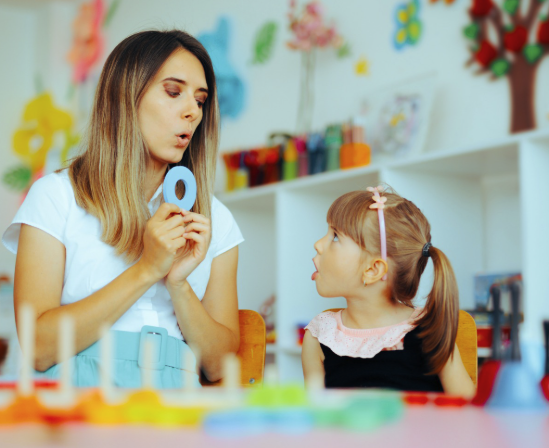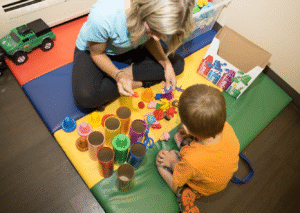Understanding the Role of Speech Therapy in Autism
When a child receives an Autism Spectrum Disorder (ASD) diagnosis, one of the most common areas of concern for parents and caregivers is communication. Many children with autism experience challenges with speech, language, and social interaction, which can impact their ability to express needs, connect with others, and participate in daily routines.
Speech therapy — formally known as speech-language pathology (SLP) — plays a crucial role in helping children with autism develop communication skills that foster independence, understanding, and meaningful interaction.
At Crawl Walk Jump Run Therapy Clinic, our team of expert speech-language pathologists takes an individualized, evidence-based approach to help children find their voice — whether that’s through spoken words, gestures, or alternative forms of communication.
Why Speech Therapy Is Critical After an Autism Diagnosis
Every child with autism presents differently. Some children are nonverbal or minimally verbal, while others speak fluently but struggle with social communication (knowing how and when to use language). Speech therapy helps bridge these gaps by addressing each child’s specific needs across several domains of communication, including:
- Receptive language (understanding what others say)
- Expressive language (using words, gestures, or devices to communicate)
- Social communication and pragmatics (using language appropriately in social settings)
- Articulation and speech clarity
- Nonverbal communication (eye contact, tone, gestures, and body language)
- Feeding and oral-motor skills
Because communication is foundational to learning and relationships, early and consistent speech therapy can significantly improve a child’s ability to connect, learn, and express themselves.
Early Intervention Matters
Research shows that early intervention — ideally beginning as soon as a diagnosis is made — leads to the best outcomes. The brain’s neuroplasticity (its ability to form new connections) is greatest during early childhood, making this an ideal time to introduce structured language and communication therapy.
At Crawl Walk Jump Run, our speech therapists work closely with families to establish clear goals based on the child’s developmental stage and daily life needs. Therapy might begin with simple cause-and-effect games, imitation, or play-based interactions that promote joint attention and turn-taking — essential skills that lay the groundwork for communication.
What Speech Therapy Looks Like for Children with Autism
Speech therapy for children with autism goes far beyond practicing words — it focuses on building meaningful communication in all its forms. Sessions are individualized and can include:
- Play-based therapy to encourage engagement and social connection
- Modeling and prompting techniques to teach new communication behaviors
- Picture Exchange Communication System (PECS) or AAC devices for nonverbal children
- Visual supports and social stories to enhance comprehension and reduce anxiety
- Oral motor and feeding therapy to improve muscle coordination for speech and eating
- Parent coaching to help families implement communication strategies at home
Therapy may also include sensory-based interventions to support regulation and attention, as many children with autism struggle with sensory sensitivities that impact their ability to focus during communication tasks.
Building Social Communication and Connection
For many children with autism, social communication — using language to connect with others — can be one of the biggest challenges. Speech therapy helps children learn how to:
- Greet others appropriately
- Take turns in conversation
- Interpret tone of voice, body language, and facial expressions
- Understand figurative language, humor, or abstract concepts
- Respond to questions and engage in back-and-forth dialogue
Therapists often use structured play, role-playing, and group sessions to help children practice these skills in supportive, real-world environments. Over time, this leads to increased confidence, improved peer relationships, and greater participation in school and community activities.
Integrating Speech Therapy with Other Disciplines
At Crawl Walk Jump Run, we recognize that communication doesn’t exist in isolation. Speech therapy is most effective when integrated with occupational therapy (OT) and physical therapy (PT) — addressing the sensory, motor, and cognitive components that influence speech and language development.
For example:
- Occupational therapy helps children regulate their sensory systems and maintain attention during communication tasks.
- Physical therapy supports postural control and breath support needed for speech production.
- Collaborative therapy sessions allow all three disciplines to reinforce shared goals across motor, cognitive, and social domains.
This multidisciplinary approach ensures that every child receives comprehensive care tailored to their unique strengths and challenges.
Family Involvement and Home Carryover
Family participation is a vital part of speech therapy success. Our therapists provide education, training, and home exercises so parents can practice communication strategies in everyday settings; during meals, playtime, or transitions.
Simple strategies such as waiting for the child to initiate, labeling objects, and modeling clear and consistent language can make a tremendous difference in helping the child generalize skills beyond the therapy room.
At Crawl Walk Jump Run, we see parents and caregivers as partners in therapy — empowering them with tools to support communication growth long after each session ends.
The Power of Finding a Voice
Every child deserves the opportunity to be heard — in whatever way they communicate best. Whether through words, gestures, signs, or devices, speech therapy helps children with autism build the skills they need to share their thoughts, emotions, and personality with the world.
With patience, consistency, and expert guidance, children with autism can make incredible progress in communication — leading to greater independence, social success, and emotional well-being.
Take the Next Step
If your child has recently been diagnosed with autism and you’re wondering how to support their communication journey, our speech-language pathologists at Crawl Walk Jump Run Therapy Clinic are here to help.
We offer individualized speech therapy programs that address expressive, receptive, and social language needs through a compassionate, evidence-based approach.
Call our office today to schedule a free consultation and learn how our team can help your child build the skills to connect, communicate, and thrive.




